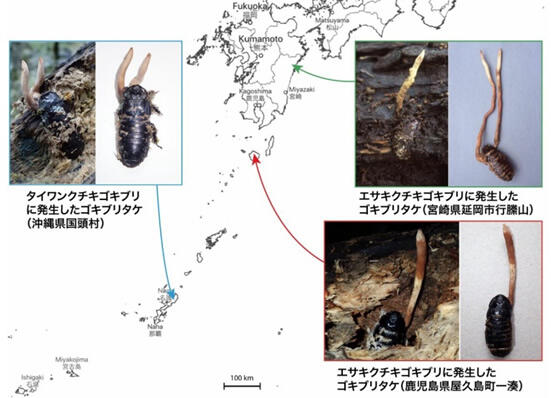University of the Ryukyus Tropical Biosphere Research Center researcher Joao Araujo, Assistant Professor Yu Matsuura, Professor Mitsuru Moriguchi of Okinawa University and members of the Japanese Society of Cordyceps Research have announced the discovery of a new species of cordyceps that parasitizes two species of Salganea, cockroaches that inhabit forest habitats. They were found in a field survey of Nobeoka, Miyazaki Prefecture, Yakushima Island in Kagoshima Prefecture and Kunigami on the main island of Okinawa. There are over 4,000 known species of cockroach worldwide, under 20 of which are found in people's homes. The rest quietly occupy outdoor habitats. Meanwhile, there are hundreds of parasitic filamentous fungi species around the world known as cordyceps. Despite that fact that many cockroach and other bug species are known to harbor parasites, it is extremely rare to find a cordyceps species hosted by cockroaches. This is the first such finding in Japan, and the third to be published worldwide, which was published in IMF Fungus.

(Credit: University of the Ryukyus, Okinawa University, the Japanese Society of Cordyceps Research and Geospatial Information Authority of Japan)
The existence of this cockroach-associated parasitic fungus was first reported 18 years ago in Miyazaki and Kagoshima Prefectures. At the time, they were given the tentative name of Hyuga gokiburi-take ("Hyuga cockroach fungus") and the members of the Japanese Society of Cordyceps Research have continued small-scale investigations since. Later, the fungus was also confirmed in Yakushima Salganea esakii and in the Yanbaru forest of northern Okinawa, a similar fungus was found in Salganea taiwanensis. However, their actual identity and relationship among them was not known.
Thus, the research team, combining morphological observations and analysis of several DNA sequences, confirmed it as a new species, Ophiocordycepsophiocordyceps. As a result of further molecular phylogenetic analysis, it is presumed to be a species of the same group as the parasitic fungi found in cockroaches in Sri Lanka and more recently in Thailand. Next, recovery analysis was performed using evolutionary parasite fungi host data from known species. It suggests that the cockroach fungus evolved from a termite parasite ancestor.
In this study, using the cockroach found in Okinawa as the type specimen, the fungus has been formally named and published as Ophiocordyceps salganeicola, in light of its host being a Salganea cockroach. As for its Japanese name, they are considering changing it to Kuchiki gokiburi-take ("Salganea cockroach fungus") in light of its discovery on two species of Salganea, found sticking out of the end of a decaying log.
The host Salganea are known for displaying a social nature, with both parents raising their offspring. Moreover, from past studies, over 50 of the cockroach fungi have been found on Yakushima and in the Yanbaru forest of Okinawa. Almost all were observed during the spring and early summer wet season, on one or two adult cockroaches inhabiting the same log. From these ecological records, it is likely that infection spreads at the time of young adult cockroach breeding season in spring.
However, the research group's findings are a taxonomical record based on a limited number of specimens. The tiny number of examples of cockroach parasites worldwide means that it is difficult to understand the details of their evolution and ecology. In future, a wider area needs to be surveyed to locate further examples of cockroach parasites together with molecular system analysis and new species description, but verification is also required from a long-term perspective in collaboration with those who research the host cockroach species.
Cordyceps are a group in which a large number of fascinating discoveries have been made in the past, not just in the area of applications in medicine and insect pest control but in the areas of host behavior manipulation and evolution from parasitism to symbiosis. There are likely to be all sorts of cordyceps yet to be discovered around the Ryukyu archipelago and the rest of Japan. At the same time, cordyceps are a valuable indicator of biodiversity in warm, humid forests. Japan is at an advantage because research is continued every day by collectors and field researchers in their field studies. The research group is planning to develop their study further by introducing the latest analysis tools from specialist fields such as mycology and genetics.
This publication progresses understanding of the ecology and diversity of cordyceps, about which much remains a mystery. Hopefully the findings can be harnessed for environmental conservation in the Ryukyus as well as applied research.
This article has been translated by JST with permission from The Science News Ltd.(https://sci-news.co.jp/). Unauthorized reproduction of the article and photographs is prohibited.




